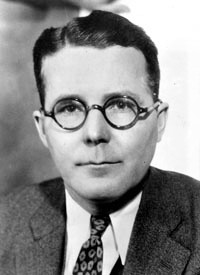
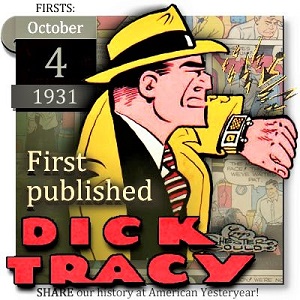 Dick Tracy (1934-48) began the serial “The Black Pearl of Osiris” on February 8, 1938. The brainchild of Chester Gould (1900-1985, photo at right) Dick Tracy debuted on October 4, 1931 as a comic strip in The Detroit Daily Mirror. Gould retired from the strip in 1977, though others continued the financially lucrative enterprise in numerous comic book editions, the syndicated newspaper strip, and in film. Dick Tracy in all of its formats (newspapers, comics, radio, tv, and film) has long been a worldwide favorite, and so much has been written about the character over the decades that it would be impossible to note all but the barest essentials here.
Dick Tracy (1934-48) began the serial “The Black Pearl of Osiris” on February 8, 1938. The brainchild of Chester Gould (1900-1985, photo at right) Dick Tracy debuted on October 4, 1931 as a comic strip in The Detroit Daily Mirror. Gould retired from the strip in 1977, though others continued the financially lucrative enterprise in numerous comic book editions, the syndicated newspaper strip, and in film. Dick Tracy in all of its formats (newspapers, comics, radio, tv, and film) has long been a worldwide favorite, and so much has been written about the character over the decades that it would be impossible to note all but the barest essentials here.
The radio show was produced and aired first in the New England area in 1934. By 1937 the comic strip had become so popular that it was syndicated in over 700 newspapers; thus, with such a broad national following it was no surprise that by the 1938-39 radio season it was airing five nights a week in 15-minute serial installments. Even so, with the approach of WWII it was put on hold until 1943, when it once again hit the airwaves and ran successfully until 1948, and in the mid-40s it even dallied for awhile with a full 30 minute format.
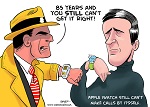 Dick Tracy became the symbol for the no-nonsense, pro-law enforcement police detective, and Gould provided Tracy with assorted over-the-top crooks and villains for whom his detective showed no quarter. The colorful names Gould gave his villains became one of the strip’s hallmarks, with names like Pruneface, Shaky, Flyface, Flattop, Mumbles, Coffyhead, and B. O. Plenty among many dozens of others from 1931 to 2017. This sort of naming wasn’t confined to villains, for other characters answered to names like Vocal Chord, Doris Chorus, and Snowflake, to name but a few. Another element for which Tracy became known was his use and reliance on the art of scientific detection methods–we’re all familiar with his two-way wrist radio that later incorporated a watch-sized television screen (eat your heart out Apple, which is only now catching up to Gould and Tracy). To help Tracy in his crime fighting adventures, he had a sidekick, Pat Patton, Junior Tracy, and his love interest Tess Trueheart (with whom in later years fans would wonder if Tracy and Trueheart would ever get married).
Dick Tracy became the symbol for the no-nonsense, pro-law enforcement police detective, and Gould provided Tracy with assorted over-the-top crooks and villains for whom his detective showed no quarter. The colorful names Gould gave his villains became one of the strip’s hallmarks, with names like Pruneface, Shaky, Flyface, Flattop, Mumbles, Coffyhead, and B. O. Plenty among many dozens of others from 1931 to 2017. This sort of naming wasn’t confined to villains, for other characters answered to names like Vocal Chord, Doris Chorus, and Snowflake, to name but a few. Another element for which Tracy became known was his use and reliance on the art of scientific detection methods–we’re all familiar with his two-way wrist radio that later incorporated a watch-sized television screen (eat your heart out Apple, which is only now catching up to Gould and Tracy). To help Tracy in his crime fighting adventures, he had a sidekick, Pat Patton, Junior Tracy, and his love interest Tess Trueheart (with whom in later years fans would wonder if Tracy and Trueheart would ever get married).
Chester Gould grew up near Chicago during the era of Al Capone and other syndicated crime bosses who fueled organized crime around the country–and Eliot Ness who fought the likes of Capone and his ilk. During the 1930s and 40s, Tracy’s hard line approach to tracking down and apprehending criminals was supported by the overwhelming majority of his listeners and readers, but attitudes in the real world were slowly changing and by the late 1950s and into the 1960s certain factions began to heavily question and criticize Tracy as being too much of a right-wing character and overly supportive of the police. The result was a decline in readership, at which point Tracy focused on more forward-looking stories, including those of the science fiction stripe with adventures set on the moon. But that didn’t last long, for when Apollo 11 landed on the moon Gould dropped the SF storyline and returned to the tried-and-true Tracy format of combatting urban crime.


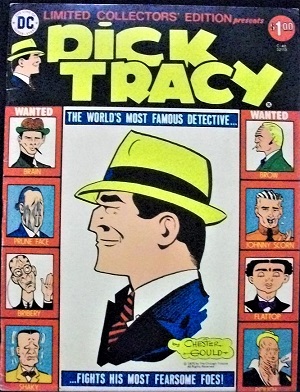
{From 1945-47 RKO Pictures made four Tracy films. Pictured below is a poster for Dick Tracy Meets Gruesome, with Boris Karloff as Gruesome and Ralph Byrd as Tracy, 1947}
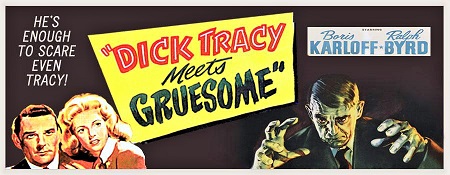
“The Black Pearl of Osiris” has Tracy coming to the aid of a renowned Egyptologist who is transporting antiquities and is being followed and threatened by an enigmatic Man With the Yellow Face. It seems that among the Egyptian relics there is one in particular (that our Egyptologist swears he is unaware of) that is sacred to the cult of Osiris (god of the underworld and the dead), and as you might surmise the Man With the Yellow Face will do anythng to retrieve it for the cult’s devotees. But is the professor telling the truth? And just who is the Man With the Yellow Face, and does he command supernatural powers as the professor is certain he does, due to strange happenings aboard the ship that are seemingly otherwise unexplainable? “The Black Pearl of Osiris” is a multi-part serial running to 14 episodes, and while I hate not running the whole story, it is not feasible in this venue to do so. That said, the first four parts below (almost a full hour’s worth) will give you a fair idea, a taste of what the Dick Tracy radio show had to offer in a broad sense, and provide another small brick in the historical wall that was considered the Golden Age of Radio. Of the show’s many episodes only a relative few remain, with most estimates settling around the 70-74 mark, with an outlier source reporting as many as approx. 120, though a goodly number of them are of extremely inferior audio quality. From the 1938-39 era the only serials to have survived are “The Black Pearl of Osiris” and “Purple Rider.” So whether you are coming to Dick Tracy for the first time or are revisiting an old friend, I hope you enjoy these opening episodes of “The Black Pearl of Osiris.”
“The Black Pearl of Osiris” – Feb. 8, 1938
Play Time: 14:54
“Pat Goes Overboard” – Feb. 9, 1938
Play Time: 14:49
“Mystery in the Hold” – Feb. 10, 1938
Play Time: 14:48
“Dick is Shot” – Feb. 11, 1938
Play Time: 14:42
{The last throes of the Great Depression and the cold of February 1938 did not deter the neighbohood gang from spending their hard-earned nickels and dimes at the corner newsstand on their favorite pulp magazines. Monthly issues of Astounding SF (1930-present, now Analog) were not to be missed. Doc Savage (1933-49) was in its heyday and reliably provided action and high adventure with Doc and his gang. It was a solid monthly until 1946, and then from 1947 until its demise in 1949 it tapered off and printed but 15 issues over its final three years. Weird Tales (1923-54, the first of several incarnations), the “unique” magazine offered tales of the odd, the strange, the unusual, dark and supernatural, and with covers like the one below was also a favorite for young imaginations to stretch their metaphorical wings. Speaking of the cover below, it was one of many painted by the first female artist to illustrate covers for the pulps, the one and only Margaret Brundage (1900-1976). Noted for her delicious and seductive nude and semi-nude covers, some of her original cover illustrations now sell in the neighborhood of $40,000-$50,000 apiece. For those interested in viewing more of her iconic Weird Tales cover art there is a website loaded with a five page gallery of it here.}
[Left: Astounding, Feb. 1938 – Center: Doc Savage, Feb. 1938 – Right: Weird Tales, Feb. 1938]
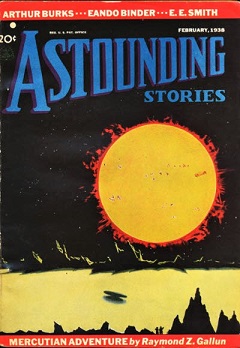
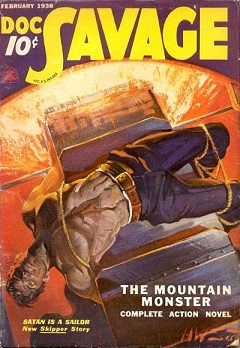
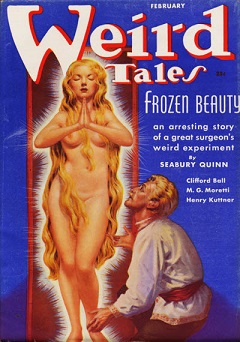
To view the entire list of weekly Old Time Radio episodes at Tangent Online, click here.